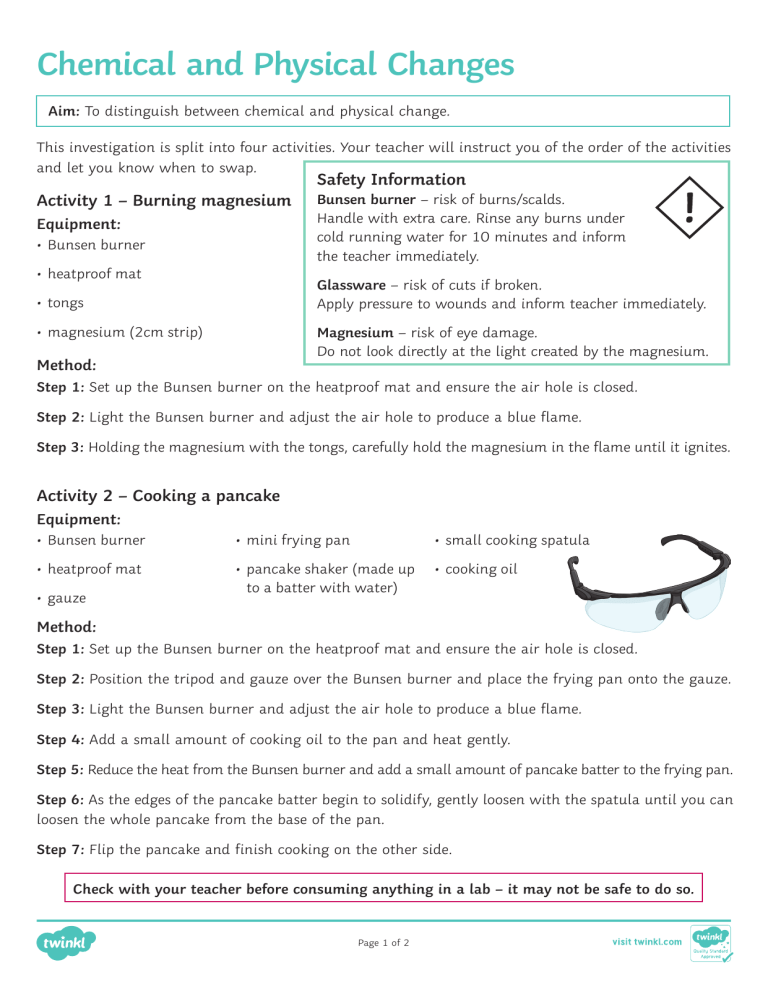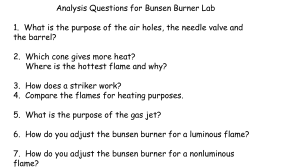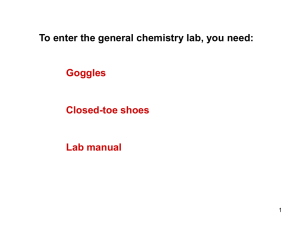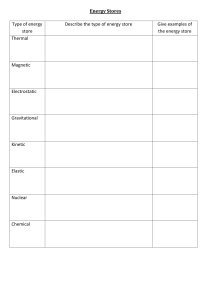t3-sc-761-chemical-and-physical-changes-investigation-instruction-sheet-printout-english ver 2
advertisement

Chemical and Physical Changes Aim: To distinguish between chemical and physical change. This investigation is split into four activities. Your teacher will instruct you of the order of the activities and let you know when to swap. Activity 1 – Burning magnesium Equipment: • Bunsen burner • heatproof mat Safety Information Bunsen burner – risk of burns/scalds. Handle with extra care. Rinse any burns under cold running water for 10 minutes and inform the teacher immediately. Glassware – risk of cuts if broken. Apply pressure to wounds and inform teacher immediately. • tongs • magnesium (2cm strip) Magnesium – risk of eye damage. Do not look directly at the light created by the magnesium. Method: Step 1: Set up the Bunsen burner on the heatproof mat and ensure the air hole is closed. Step 2: Light the Bunsen burner and adjust the air hole to produce a blue flame. Step 3: Holding the magnesium with the tongs, carefully hold the magnesium in the flame until it ignites. Activity 2 – Cooking a pancake Equipment: • Bunsen burner • mini frying pan • small cooking spatula • heatproof mat • pancake shaker (made up to a batter with water) • cooking oil • gauze Method: Step 1: Set up the Bunsen burner on the heatproof mat and ensure the air hole is closed. Step 2: Position the tripod and gauze over the Bunsen burner and place the frying pan onto the gauze. Step 3: Light the Bunsen burner and adjust the air hole to produce a blue flame. Step 4: Add a small amount of cooking oil to the pan and heat gently. Step 5: Reduce the heat from the Bunsen burner and add a small amount of pancake batter to the frying pan. Step 6: As the edges of the pancake batter begin to solidify, gently loosen with the spatula until you can loosen the whole pancake from the base of the pan. Step 7: Flip the pancake and finish cooking on the other side. Check with your teacher before consuming anything in a lab – it may not be safe to do so. Page 1 of 2 Chemical and Physical Changes Activity 3 – Boiling water Equipment: • Bunsen burner • heatproof mat • gauze • beaker • thermometer Method: Step 1: Set up the Bunsen burner on the heatproof mat and ensure the air hole is closed. Step 2: Position the tripod and gauze over the Bunsen burner and place the beaker onto the gauze. Step 3: Add 150ml of water to the beaker and place the thermometer into the water. Step 4: Light the Bunsen burner and adjust the air hole to produce a blue flame. Step 5: Heat the water gently until you see bubbles begin to form and the water starts to boil. Step 6: Switch off the Bunsen burner and leave the equipment to cool. Activity 4 – Melting chocolate Equipment: • Bunsen burner • heatproof mat • gauze • beaker • square of chocolate Method: Step 1: Set up the Bunsen burner on the heatproof mat and ensure the air hole is closed. Step 2: Position the tripod and gauze over the Bunsen burner and place the beaker onto the gauze. Step 3: Add the piece of chocolate to the beaker. Step 4: Light the Bunsen burner and adjust the air hole to produce a blue flame. Step 5: Heat the chocolate gently until you see that it is beginning to melt and become liquid. Step 6: Switch off the Bunsen burner and leave the equipment to cool. Check with your teacher before consuming anything in a lab – it may not be safe to do so. Page 2 of 2 Chemical and Physical Changes Results Activity 1 – Burning magnesium Activity 2 – Cooking a pancake Physical or chemical change? Physical or chemical change? How do you know? How do you know? Activity 3 – Boiling water Activity 4 – Melting chocolate Physical or chemical change? Physical or chemical change? How do you know? How do you know? Chemical and Physical Changes Results Activity 1 – Burning magnesium Activity 2 – Cooking a pancake Physical or chemical change? Physical or chemical change? How do you know? How do you know? Activity 3 – Boiling water Activity 4 – Melting chocolate Physical or chemical change? Physical or chemical change? How do you know? How do you know? Page 3 of 2 Chemical and Physical Changes Results Answers Activity 1 – Burning magnesium Activity 2 – Cooking a pancake Physical or chemical change? Physical or chemical change? chemical chemical How do you know? How do you know? A new substance is made. A new substance is made. Activity 3 – Boiling water Activity 4 – Melting chocolate Physical or chemical change? Physical or chemical change? physical physical How do you know? How do you know? No new substance is made. No new substance is made. Chemical and Physical Changes Results Answers Activity 1 – Burning magnesium Activity 2 – Cooking a pancake Physical or chemical change? Physical or chemical change? chemical chemical How do you know? How do you know? A new substance is made. A new substance is made. Activity 3 – Boiling water Activity 4 – Melting chocolate Physical or chemical change? Physical or chemical change? physical physical How do you know? How do you know? No new substance is made. No new substance is made. Page 4 of 2






